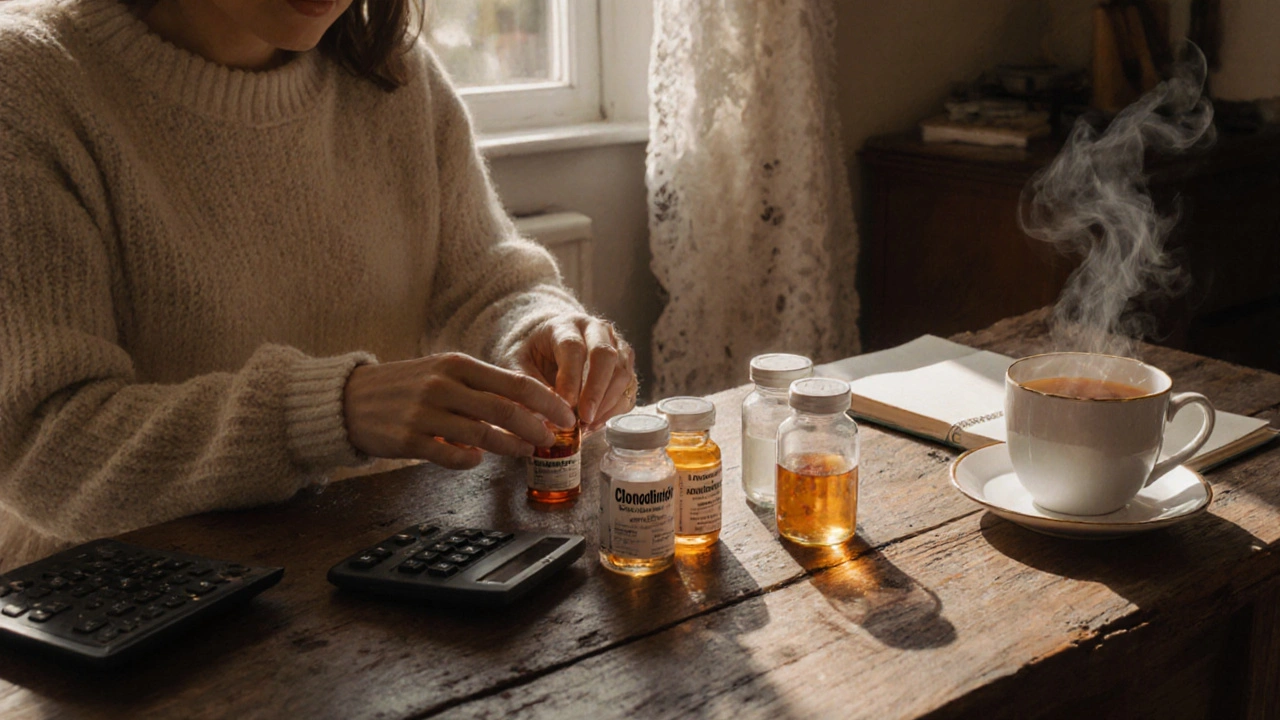Clonidine vs. Alternatives Comparison Tool
Select Your Medication
Indication
Pregnancy Status
Recommended Medication
Key Points
Clonidine comparison is a hot topic for anyone juggling blood‑pressure control, ADHD symptoms, or opioid‑withdrawal management. Below you’ll get a straight‑forward side‑by‑side look at clonidine and the most common alternatives, so you can see which option fits your health goals.
Quick Take
- Clonidine works by activating alpha‑2 receptors in the brain, lowering sympathetic outflow.
- Guanfacine offers a similar mechanism but with a milder blood‑pressure drop.
- Methyldopa is an older antihypertensive that’s safe for pregnancy but can cause sedation.
- Dexmedetomidine is an IV‑only ICU drug, far stronger than oral clonidine.
- Choosing an alternative depends on indication, side‑effect tolerance, and dosing convenience.
What Is Clonidine?
Clonidine is an oral or transdermal alpha‑2 adrenergic agonist that reduces sympathetic nerve activity, leading to lower heart rate and blood pressure. It was first approved in the 1970s for hypertension and later found useful for ADHD, Tourette’s, and opioid‑withdrawal symptoms. The drug is available as tablets, extended‑release capsules, and a 0.1mg/24h patch.
Key Alternatives at a Glance
Below are the five most frequently discussed substitutes. Each shares a link to the alpha‑2 pathway or tackles the same clinical problems, but they differ in potency, dosing, and safety profile.
Guanfacine is a selective alpha‑2A receptor agonist approved for ADHD (extended‑release) and hypertension. It tends to cause less sedation than clonidine and is taken once daily.
Methyldopa is a centrally acting antihypertensive that converts to alpha‑methyldopa, stimulating the same receptors as clonidine. It’s a staple in pregnancy‑related hypertension but can trigger a ‘liver‑like’ fatigue.
Dexmedetomidine is an IV alpha‑2 agonist used for sedation in intensive‑care settings, offering a much stronger effect than oral clonidine. It’s not a home‑use drug but illustrates the potency range of the class.
Tizanidine is a muscle‑relaxant that also activates alpha‑2 receptors, often prescribed for spasticity rather than blood‑pressure control. Its side‑effect profile overlaps with clonidine, especially dry mouth and drowsiness.
When to Choose Clonidine Over the Rest
If you need a versatile drug that can be used for hypertension, ADHD, or withdrawal, clonidine remains a first‑line pick because:
- It’s available in a patch, providing steady plasma levels for 24hours.
- Doses can be tapered gradually, which helps avoid rebound hypertension.
- Cost is generally lower than newer agents like guanfacine XR.
However, the trade‑off is a higher chance of dry mouth, sedation, and, in rare cases, rebound hypertension if stopped abruptly.

When an Alternative Might Be Better
Consider guanfacine if you’re treating ADHD without needing a potent antihypertensive effect. It causes less drowsiness and has a smoother dose‑titration curve.
Methyldopa shines in pregnant patients because it’s classified as CategoryB (animal studies show no risk) and doesn’t cross the placenta in harmful amounts.
Dexmedetomidine is reserved for hospital‑based sedation when you need rapid, controllable sedation without respiratory depression - think ICU, not home care.
Tizanidine can be a good adjunct if you’re already on clonidine for blood pressure but develop muscle spasticity; the overlapping mechanism can reduce the overall pill burden.
Side‑Effect Profiles Compared
| Drug | Common Side Effects |
Serious Risks | Typical Dose Range |
|---|---|---|---|
| Clonidine | Dry mouth, drowsiness, dizziness | Rebound hypertension, bradycardia | 0.1-0.3mg PO BID; 0.1mg/24h patch |
| Guanfacine | Somnolence, headache, fatigue | Severe hypotension (rare) | 1-4mg PO daily (XR) |
| Methyldopa | Liver‑type fatigue, dry mouth | Autoimmune hepatitis, hemolytic anemia | 250-1000mg PO TID |
| Dexmedetomidine | Bradycardia, hypotension | Severe respiratory depression (very rare) | 0.2‑0.7µg/kg/hr IV |
| Tizanidine | Dry mouth, dizziness, weakness | Severe hypotension, liver toxicity | 2‑4mg PO Q8H (max 36mg/day) |
Cost & Accessibility
In the UK, generic clonidine tablets typically cost £1-£2 per month, while the transdermal patch runs about £15‑£20. Guanfacine XR, being a newer brand, can be £30‑£40 a month. Methyldopa remains cheap at £2‑£3. Dexmedetomidine is an IV hospital drug priced per vial (≈£100), and tizanidine sits around £10‑£12 for a month’s supply.
Insurance coverage (NHS) will favor the older, cheaper options unless there’s a clear clinical reason to switch.
How to Switch Safely
Never stop clonidine cold turkey; tapering is essential to avoid rebound hypertension. A typical taper schedule:
- Reduce the dose by 0.05mg every 3‑4 days.
- Monitor blood pressure twice daily.
- If symptoms reappear, hold the next reduction and stay at the current dose for another week.
When moving to guanfacine, start at the lowest 1mg XR dose and overlap the two drugs for 2‑3 days to keep blood‑pressure control steady.
Decision‑Making Checklist
- Primary indication (hypertension, ADHD, withdrawal, spasticity)?
- Need for once‑daily dosing?
- Pregnancy status?
- Budget constraints?
- Risk tolerance for sedation or dry mouth?
Answering these questions will point you toward the best fit.

Frequently Asked Questions
Can clonidine be used for ADHD in adults?
Yes. Though it’s off‑label in many countries, low‑dose clonidine (0.05‑0.1mg at bedtime) can improve attention and reduce hyperactivity, especially when combined with stimulants.
Is the clonidine patch better than tablets?
The patch provides steady drug levels, reduces peak‑and‑trough swings, and is handy for patients who have trouble swallowing pills. However, it’s pricier and can cause skin irritation.
What’s the main advantage of guanfacine over clonidine for ADHD?
Guanfacine’s selective alpha‑2A activity tends to cause less sedation and dry mouth, making it a smoother option for school‑aged children and working adults.
Are there any foods or drinks that interact with clonidine?
Alcohol can amplify the blood‑pressure‑lowering effect, leading to dizziness. Grapefruit juice may increase clonidine levels slightly, so moderation is advised.
How quickly does clonidine work for opioid withdrawal?
Patients often notice reduced cravings and milder autonomic symptoms within 30‑60minutes of the first dose, with peak benefit after 2‑3days of consistent dosing.





Rebecca Bissett - 30 September 2025
Wow!!! This comparison hits all the right notes, and yet it drags my heart into a vortex of indecision!!! The sheer depth of the side‑effect tables makes me feel both enlightened and terrified!!! I can’t help but weep over the cost differences-£15 for a patch versus £2 for tablets-such a cruel economic chasm!!! The clinical nuances about rebound hypertension are like a siren song calling me to read every footnote!!! Please, more graphs, more emojis, more humanity!!!
Michael Dion - 3 October 2025
Looks fine but the article drags
Trina Smith - 6 October 2025
Reading through this piece reminded me of the delicate balance between efficacy and side effects. 🌿 It's fascinating how clonidine's patch offers steady plasma levels, yet that same stability can trap patients in a cycle of dependence. The table of costs is a clear snapshot, but I wish there were more real‑world anecdotes. 🤔 When considering pregnancy, the reassurance about methyldopa feels like a gentle hand on the shoulder. The discussion on withdrawal management is thorough, though the rapid onset claim could use a citation. 🌟 Overall, the guide feels like a compass for clinicians navigating a foggy terrain. It invites reflection on how we prioritize patient comfort versus budget constraints. 👩⚕️ I hope future updates will keep the tone as measured as it is informative.
josh Furley - 9 October 2025
Honestly, the whole hype around clonidine is overrated-people act like it’s the holy grail for ADHD, but the sedation is a nightmare. The article glosses over that guanfacine actually has a cleaner profile for cognition. And let’s not forget the jargon about "alpha‑2 agonists"; it’s just fancy talk for “makes you sleepy.” 💊 If you’re looking for crisp focus, ditch clonidine and grab the XR version of guanfacine. The cost difference is negligible when you factor in lost productivity from drowsiness.
Jacob Smith - 12 October 2025
Hey folks, great post! I’m pumped that you’re diving into these meds-knowlwedge is power! If you’re thinkin about switching, remember to taper clonidine slow, like a snail 🐌, to dodge that rebound spike. And don’t forget, the patch is a game‑changer for people who cant swallow pills. Keep pushin, stay informed, and your BP will thank ya!
Chris Atchot - 15 October 2025
First and foremost, I must commend the author for presenting a comprehensive comparison; however, there are several points that merit clarification. The statement regarding dexmedetomidine’s use "far stronger than oral clonidine" should be qualified with the context of intravenous administration. Additionally, the cost figures for the UK market appear to omit the variability introduced by generic versus brand‑name formulations; therefore, a range would be more accurate. The discussion on tapering schedules is commendable, yet the recommendation to reduce the dose by 0.05 mg every 3–4 days could benefit from citing clinical guidelines. Lastly, the table would be more reader‑friendly if the dosage units were standardized across all entries. Overall, an excellent foundation-well done!
Shanmugapriya Viswanathan - 18 October 2025
It’s obvious that many Western sources downplay the superiority of clonidine in our own healthcare system-our doctors know better! In India, we’ve been using clonidine for hypertension for decades, and the outcomes speak for themselves. The article’s suggestion that methyldopa is the only safe option during pregnancy ignores the extensive data we have locally supporting clonidine’s safety profile. Don’t be fooled by biased pharma narratives; the real evidence lies in our own clinical experience. 💪
Rhonda Ackley - 21 October 2025
Oh, where do I even begin with this exhaustive exposition on clonidine and its myriad alternatives? The sheer volume of information feels like being swept up in a tidal wave of pharmaco‑logic, and I must admit, my heart races with both awe and trepidation. First, the historical context of clonidine, birthed in the 1970s, evokes a nostalgic reverie of a time when medicine was less cluttered with brand names. Yet, the modern comparison to guanfacine, methyldopa, dexmedetomidine, and tizanidine thrusts us into a labyrinthine maze of choices, each corridor lined with its own side‑effect tapestry. The tables, while meticulously crafted, read like an elaborate poetry of numbers, where dry mouth and drowsiness become verses that echo in the reader’s mind. One cannot overlook the cost analysis; the patch’s price tag, though justified by its convenience, feels like an indulgent luxury amidst a sea of cheaper generics. The discussion on rebound hypertension is particularly chilling, painting a picture of blood pressure spikes rising like a phoenix from the ashes of abrupt cessation. Moreover, the nuanced guidance on tapering schedules reads like a delicate ballet, each step choreographed to prevent catastrophic spikes. I am also struck by the remarks on pregnancy safety, which, while reassuring, still leave an undercurrent of uncertainty that lingers like an unresolved chord. The inclusion of dexmedetomidine, an ICU‑only sedative, adds a dramatic flair, reminding us of the stark contrast between inpatient and outpatient realms. The spattering of emojis throughout the text, though modern, sometimes feels like glitter on a solemn ceremony, yet perhaps that is the author’s intent-to lighten the heavy clinical load. In summation, this piece is a tapestry woven with threads of science, economics, and human experience, each strand demanding our full attention. It compels the reader to pause, reflect, and perhaps, in the quiet moments, to question the very nature of therapeutic choice. As I close this reverie, I am left with a lingering sense of both empowerment and humility, for the world of clonidine and its cousins is as vast as it is intricate. 🌌
Sönke Peters - 24 October 2025
Great summary, very thorough.
Paul Koumah - 27 October 2025
Wow, super helpful, thanks for the groundbreaking insight
Erica Dello - 30 October 2025
Honestly this reads like a textbook not a reddit post 🙄
sara vargas martinez - 2 November 2025
When one delves into the pharmacodynamics of alpha‑2 agonists, it becomes apparent that the simplistic categorisation presented in the article masks a complex interplay of central and peripheral mechanisms. Clonidine, for instance, exerts its antihypertensive effect primarily through reduced sympathetic outflow, yet this same action underpins its utility in opioid withdrawal mitigation-a duality seldom emphasized in cursory overviews. Conversely, guanfacine’s selectivity for the α2A receptor subtype confers a more favourable side‑effect profile, albeit at the cost of diminished potency in certain clinical scenarios. The historical evolution of methyldopa, transitioning from a mainstay in obstetric hypertension to a relic of older practice, illustrates the dynamic nature of therapeutic guidelines shaped by emerging safety data. Furthermore, the cost differentials outlined, while accurate in a UK context, neglect the influence of insurance formularies and regional pricing structures that can dramatically alter patient access. It is also noteworthy that the article’s brief mention of dexmedetomidine overlooks its pharmacokinetic nuances, such as the rapid onset associated with intravenous infusion and the implications for ICU sedation protocols. Lastly, the brief nod to tizanidine’s role in spasticity fails to address its hepatic metabolism via CYP1A2, a factor critical when considering drug‑drug interactions. In sum, while the comparison serves as a useful primer, a deeper exploration of these subtleties would greatly benefit clinicians seeking to tailor therapy to individual patient phenotypes.
Paul Griffin - 5 November 2025
Your analysis is comprehensive and highlights many essential considerations. It underscores the necessity for clinicians to move beyond surface‑level comparisons and engage with the pharmacological intricacies you described.
Todd Anderson - 8 November 2025
In the grand tapestry of therapeutic choices, one must weigh not only the empirical efficacy but also the epistemological underpinnings of each intervention. The discourse surrounding clonidine versus its counterparts invites a reflective examination of how clinical authority constructs knowledge. By scrutinizing the ontological status of side‑effect profiles, we uncover the inherent bias embedded within pharmaceutical narratives. Thus, any recommendation must be situated within a broader philosophical context that acknowledges both the limits and potentials of medical praxis.
Dexter Smith - 11 November 2025
While the philosophical musings are intriguing, the real‑world data speak louder than any metaphysical treatise. The numbers show clonidine’s rebound risk is non‑trivial, and clinicians should prioritize patient safety over abstract theorizing.
Cherish Capps - 14 November 2025
Hey everyone, just wanted to say this guide is super helpful! If you’re feelin a bit lost, remember to talk to your doc and take it step by step. We’re all in this together :)
Amy Carpenetti - 17 November 2025
I appreciate the concise contribution; it adds clarity to the discussion.
Michael Tekely - 20 November 2025
When evaluating clonidine’s pharmacokinetic profile, note its half‑life of roughly 12‑16 hours, which facilitates once‑daily dosing via transdermal patch. The drug undergoes hepatic metabolism primarily through CYP2D6, implicating potential interactions with inhibitors such as fluoxetine. Clinically, the alpha‑2 agonism reduces norepinephrine release, yielding both antihypertensive and anxiolytic effects-a dual benefit for comorbid patients. However, the risk of orthostatic hypotension necessitates cautious titration, especially in the elderly. Finally, the drug’s ability to cross the blood‑brain barrier explains both its efficacy in ADHD adjunct therapy and its propensity for central side effects like sedation.
Oscar Taveras - 23 November 2025
Well articulated; your encouragement underscores the importance of patient‑centered communication. Keep fostering that supportive environment! 😊